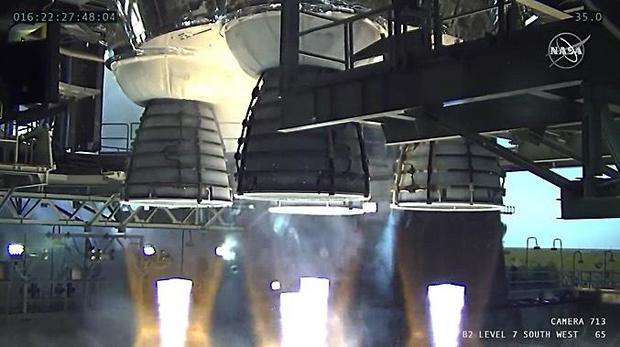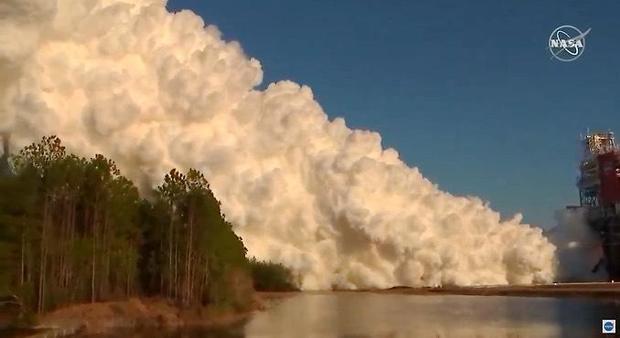Engineers test fired the first stage of NASA’s gargantuan Space Launch System rocket for the first time Saturday, but the planned eight-minute-long “hot fire” ended about a minute after ignition when one of the four main engines suddenly shut down.
What impact the abort at the Stennis Space Center in Mississippi might have on NASA’s future plans for the rocket is unclear. The agency plans to ship the booster to the Kennedy Space Center in Florida for an unpiloted maiden test flight and has long-term plans to send astronauts to the lunar surface on the rocket’s third flight.
However it plays out, it seems unlikely the huge Space Launch System stage will make it to Florida in time for a test flight this year unless the problem that derailed Saturday’s test turns out to be trivial or otherwise easy to correct.
Firmly anchored to a massive test stand throughout the ground-shaking “green run”, the 212-foot-tale Boeing-managed booster’s RS-25 engines ignited at 120 millisecond intervals at 5:27 p.m. ET, throttling up to full power to generate a combined 1.6 million pounds of thrust.
As the super-heated exhaust hit torrents of cooling water flooding the B-2 test stand’s flame deflector directly below the engine nozzles, a churning jet of steam blasted away to one side, sending billowing white clouds into the clear Mississippi sky.
While rockets quickly fade from view and hearing as they climb toward space, the SLS booster remained in place, filling the countryside with a roar as the main engines began consuming the rocket’s load of more than 700,000 gallons of liquid oxygen and hydrogen propellants.
Mirroring the procedures that will be needed when the rocket takes off for real, the engines were expected to throttle down about one minute after ignition to simulate passage through the region of maximum aerodynamic stress. The engine nozzles then were to be hydraulically moved to verify the flight computer’s ability to steer the huge rocket as required.
But about 50 seconds after engine ignition, a test controller called out “MCF on engine 4,” using an acronym believed to stand for “major component failure.” The test director replied, “copy that, but we’re still running, still got four good engines, right?”
A few seconds later, the exhaust plume of an engine, presumably number 4, began changing, dropping in intensity as a controller reported several “violations” in the telemetry stream. Moments later, the test conductor called “we’ve got a shutdown.”
The computer-orchestrated engine shutdown sequence appeared to go smoothly and the rocket was quickly “safed.” There was no apparent damaged.
It was a disappointing conclusion to the long-awaited test, which engineers had planned to run for the full eight minutes it will take the rocket to climb to space on its maiden flight. NASA managers were expected to provide an update later Saturday on what might have gone wrong.
For an actual launch, the Boeing-managed Space Launch System first stage will be attached to a pair of Northrop Grumman solid-fuel boosters, each one generating 3.6 million pounds of thrust, and a hydrogen-fueled upper stage topped off by a Lockheed Martin Orion crew capsule.
The fully assembled SLS rocket will weigh 5.75 million pounds, stand 322 feet tall and generate 8.8 million pounds of thrust at liftoff, making it the most powerful operational rocket in the world.
The solid-fuel boosters have been tested on their own at a Northrop Grumman manufacturing facility in Utah. The test Saturday was designed to put the hydrogen-fueled RS-25 engines through their paces, along with the booster’s propulsion system and avionics.
The hot fire, also known as a “green run” test, was expected to set the stage for the planned Artemis 1 mission later this year, an unpiloted test flight to send the Orion capsule on a flight 40,000 miles beyond the moon and back.
NASA has been attempting to follow a Trump administration schedule that called for the first piloted SLS-Orion flight — Artemis 2 — in 2023, followed by a moon landing using the third SLS rocket by the end of 2024.
But Congress has not yet provided the full funding needed for a new moon lander and the 2024 target date is no longer considered feasible. The Biden administration has not yet outlined its plans for NASA and the Artemis program.
As it stands, SLS development is well over budget and at least two years behind schedule. NASA’s inspector general reported last March that total SLS program costs were expected to climb above $18 billion by the time the Artemis 1 rocket finally takes off.
The delays and high costs have prompted debate about the need for the SLS to ferry astronauts to the moon given the availability of less powerful but much less expensive SpaceX Falcon Heavy rockets and other heavy-lift boosters now in development.
But NASA managers say the SLS is the only rocket available in the near term that is capable of accommodating the Orion crew capsule and other large components envisioned for the Artemis program.




